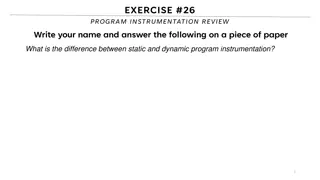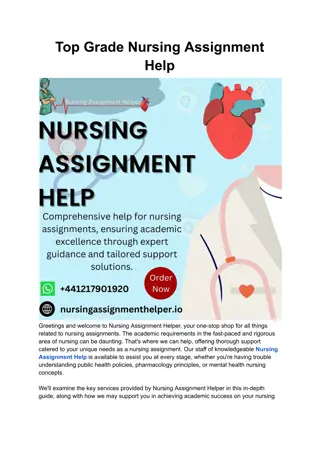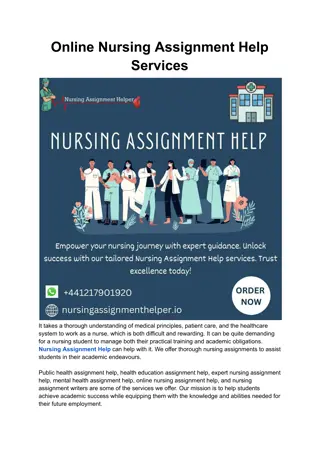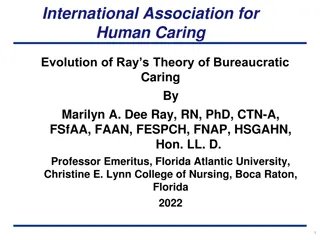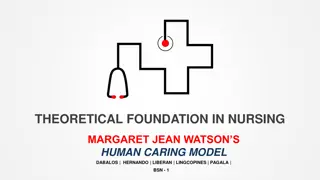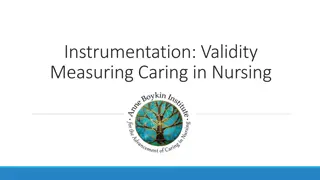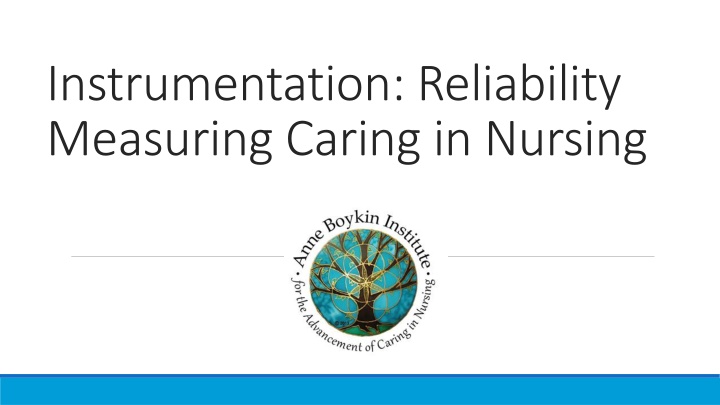
Reliability Measures in Nursing Instrumentation
Explore the concept of reliability in nursing instrumentation, focusing on quality measures, types of reliability tests, and the importance of reliable instruments in healthcare. Learn about test-retest reliability, equivalence, and how to enhance the power of nursing studies through dependable measurements.
Download Presentation

Please find below an Image/Link to download the presentation.
The content on the website is provided AS IS for your information and personal use only. It may not be sold, licensed, or shared on other websites without obtaining consent from the author. If you encounter any issues during the download, it is possible that the publisher has removed the file from their server.
You are allowed to download the files provided on this website for personal or commercial use, subject to the condition that they are used lawfully. All files are the property of their respective owners.
The content on the website is provided AS IS for your information and personal use only. It may not be sold, licensed, or shared on other websites without obtaining consent from the author.
E N D
Presentation Transcript
Instrumentation: Reliability Measuring Caring in Nursing
Reliability: Quality Measure of Instrument Dependability, stability, consistency, predictability, comparability, accuracy Indicates extent of random error in measurement method Test is reliable if observed scores are highly correlated with its true scores How consistently measurement technique measures concept/construct (same trait) (internal consistency) If two data collectors observe same event and record observations on instrument, recording is comparable (interrater) Same questionnaire administered to same individuals at two different times, individuals responses remain same (test-retest)
Reliability Instruments that are reliable provide values with only small amount of random error Reliable instruments enhance the power of the study 1.00 is perfect reliability; 0.00 is no reliability
Types of Reliability: Test-Retest test-retest (two administrations of same test with time period between administrations based on construct) comparison of means t-test: t statistic OR correlate results Pearson Product Moment Correlation or r or Spearman s rho Time1: administer the CBI to a group of nurses Time 2: administer the CBI to the same group of nurses Test-retest reliability, nurse sample (rho = .88, p < .01)
Types of Reliability: Equivalence Equivalence Interrater or interobserver: 2 observers independently observe behavior using same instrument percentage of agreement: number of agreements/number of possible agreements = interrater reliability Cohen s kappa, correlation (Phi, Pearson r; Kendall s tau; Spearman s rho) intraclass correlation coefficient (ANOVA) Alternate or parallel forms (two parallel tests based on same blueprint) Pearson r on total scores
Types of Reliability: Homogeneity Homogeneity Internal consistency Cronbach s alpha (ordinal scale items) Modest sample size: at least 25 Kuder-Richardson 20 (nominal, dichotomous items)
Reliability In a study of antepartum and postpartum patients, reliability coefficients for the Caring Behavior Assessment generated an internal consistency Cronbach s alpha of .93 for the total scale Cronbach s alpha coefficients were the following for CBI-42 subscales: Respectful deference to other ( = .94); Assurance of human presence ( = .96); Positive connectedness ( = .93); Professional knowledge and skill ( = .90); Attentiveness to the other s experience ( = .91) Reliability for the CARE-Q was initially tested in a small (N = 10) test-retest study, resulting in an r of 1.00 for one most important and one least important item The revised 10-item Caring Factor Survey (CFS), D model: a Cronbach s alpha of .96 was the final version of the 10-item CFS
Reliability Five bilingual nurses in the United States examined the consistency between the modified Chinese version of the CARE-Q and its original English version. The modified Chinese version was rated as 96% accurate for the 50 items. The internal consistency for an overall coefficient alpha is 0.97 for the total scale of the modified CARE-Q (Chinese version). The test-retest reliability of the instrument with a 2-week interval was p = 0.005. CBI-42 has demonstrated good test-retest reliability (r = 0.82) for nurses The Cronbach s alpha was 0.94 for the total CBI-24 scale (Ireland and United State nurse sample)
Reliability The Adapted Caring Behavior Checklist was used in a scenario-based, high fidelity human patient simulation based on McDaniel s checklist; items were scored on verbal and nonverbal actions denoting caring as performed by the nurse and as observable to a rater, using dichotomous (presence or absence) scoring and frequencies. Inter-rater reliability among four raters was 88% to 100% for the adapted checklist. The Peer Group Caring Interaction Scale (PGIS) was adapted for staff nurses; the alpha reliability of the PGCIS was 0.95. The Caring Nurse Observation Tool (CNOT) checklist was tested for inter-rater reliability by two pairs of independent judges; there was a 38% and 41% agreement by two pairs of independent judges; there was a 38% and 41% rate of agreement among two independent judges within each dataset; Kappa coefficients were also calculated. An observed indicator receives a score of 1 for each item.
Caring Behaviors Inventory-42 Respectful deference to other (courteous regard for the other) (3,8,1,9,11,2,4,10,7,27,15,28) 12 items; Cronbach s alpha = 0.8906 Assurance of human presence (investment in the other s need and security) (16,35,37,34,32,36,30,26,33,31,18,29) 12 items; Cronbach s alpha = 0.9221 Positive connectedness (optimistic and constant readiness of the part of the nurse to help the other) (12,25,5,14,13,6,23,21,17) 9 items; Cronbach s alpha = 0.8452 Professional knowledge and skill (proficient, informed and skillful nurse) (19,24,22,38,20) 5 items; Cronbach s alpha = 0.8157 Attentiveness to other s experience (appreciation of and engrossment in the other s perspective and experience) (40,39,41,42) 4 items; Cronbach s alpha = 0.8191
Modified (Chinese) Care Q Subscales Accessible: = 0.82 Explains and Facilitates: = 0.86 Anticipates and Comforts: = 0.92 Respects: = 0.92 Helping and Trusting Relationships: = 0.89 Monitors and Follows Through: = 0.91
Persian Caring Dimension Inventory-25 PCDI re-administered 10 days after the first visit to 20 nursing students and 18 nurses to evaluate test-retest reliability. Test retest correlation coefficients were high (Spearman correlation coefficients were 0.89 for nursing students and 0.91 for nurses). Internal consistency was calculated for entire sample of 288 participants. Alpha coefficient for overall CDI-25 was 0.91. By excluding two items, items 4 (getting to know the patient as a person) and 16 (sharing your personal problems with a patient), alpha coefficient for remaining 23 items was 0.86
References Cossette & Forbes (2012) DiNapoli, Nelson, Turkel, & Watson (2010) Dunnington & Farmer (2015) Larson (1984) Lee & Larson (2006) Longo (2009) Salimi, Azimpour, Mohammadzadeh, & Fesharaki (2014) Schultz, Bridgham, Smith, & Higgins (1998) Weathers et al. (2015) Wolf et al. (1994) Wolf et al. (1998) Wolf et al. (2003) Wolf et al. (2004)


